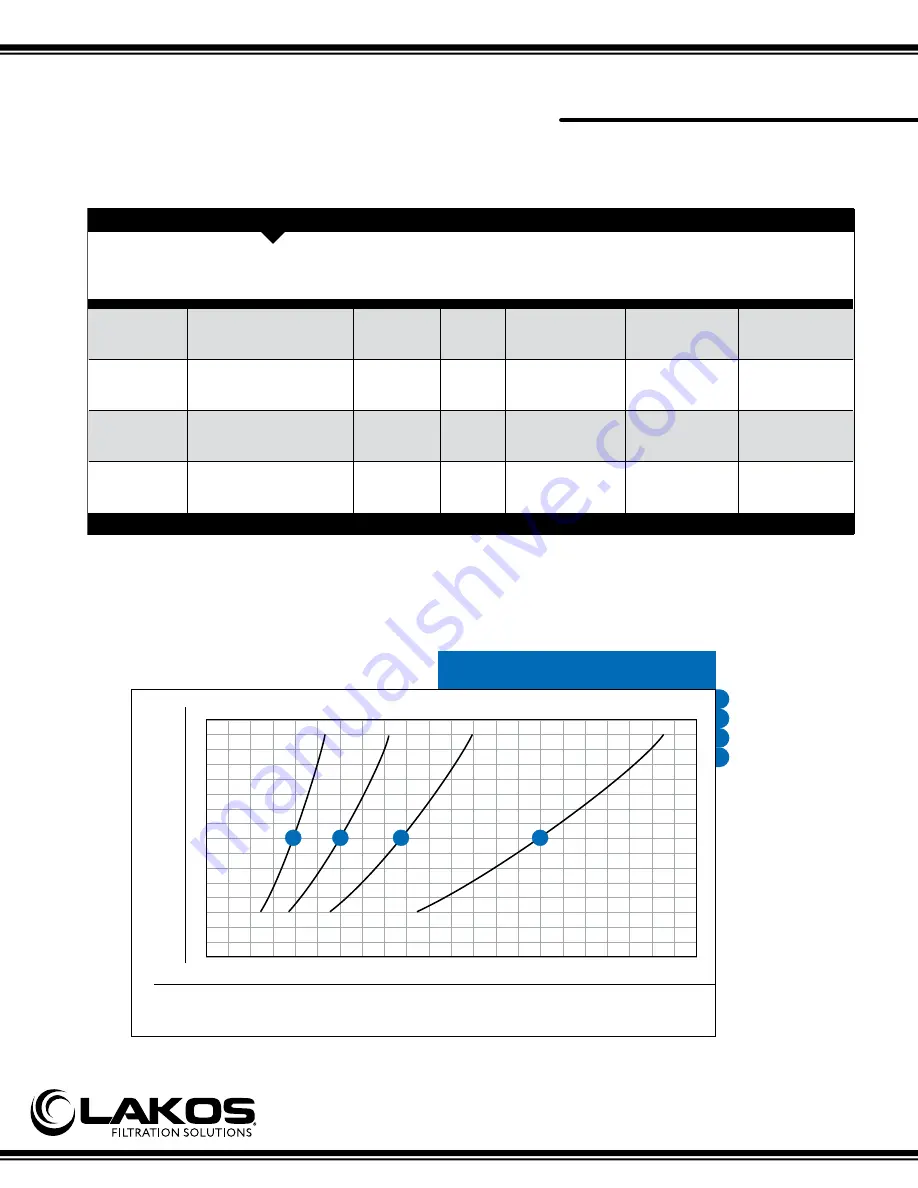
LAKOS Waterworks PWC Series Separators
4
Separator Operation
continued…
Separator Model and Flow Chart
Model
*
Flow Range
Inlet/Outlet
ANSI Flange
Size
Collection
Chamber
Capacity
Weight Empty
Weight with
Water
US gpm
m³/hr
gal
liters
lbs
kg
lbs
kg
PWC-1040-L 225-525
51-119
4 inch
0.8
3.1
547
248
889
403
PWC-1040-V 225-525
51-119
4 inch
1.6
5.9
495
224
815
370
PWC-1050-L 305-800
69-181
6 inch
0.7
2.5
775
351 1394
632
PWC-1050-V 305-800
69-181
6 inch
3.0
11.2
752
341 1370
621
PWC-1060-L 480-1275 109-289
6 inch
1.3
4.8 1108
502 2304
1045
PWC-1060-V 480-1275 109-289
6 inch
6.2
24.3 1103
500 2297
1042
PWC-1080-L 820-2050 186-465
8 inch
2.1
8.1 1694
768 3858
1750
PWC-1080-V 820-2050 186-465
8 inch
7.8
29.4 1689
766 3757
1704
Separator Model and Flow Chart
* Suffix “L” refers to low profile; suffix “V” refers to vertical profile. IMPORTANT: Separator must operate within flow range
for optimum performance
4 inch
6 inch
6 inch
8 inch
PWC-1040-L
PWC-1040-V
PWC-1050-L
PWC-1050-V
PWC-1060-L
PWC-1060-V
PWC-1080-L
PWC-1080-V
0.8
1.6
0.7
3.0
1.3
6.4
2.1
7.8
3.1
5.9
2.5
11.2
4.8
24.3
8.1
29.4
547
495
775
752
1108
1103
1694
1689
889
815
1394
1370
2304
2297
3858
3757
248
224
351
341
502
500
768
766
403
370
632
621
1045
1042
1750
1704
240-540
370-820
550-1200
940-2060
55-123
84-186
125-273
213-468
Models ending with "L" are low profile; "V" are vertical profile
Flow range is critical to separator performance. Do not oversize separator or use pipe size for model selection
See page 6 for higher flow rates and variable flow systems
1-1/2"
1-1/2"
1-1/2"
1-1/2"
Flow Range**
U.S. gpm
m
3
/hr
gal
liters
lbs.
kg
kg
lbs
Model*
Weight
Empty
Weight
with Water
Collection
Chamber Capacity
Inlet/Outlet
ANSI
Flange
Purge
Size
Male N.P.T.
*
**
Flow vs. Pressure Loss
PWC-1040
PWC-1050
PWC-1060
PWC-1080
A
B
C
D
Pressure Loss
Flow Rate
Flow range is critical for model selection. Do not use flange size.
psi
bar
(gpm)
(m
3
/hr)
16
15
14
13
12
11
10
9
8
7
6
5
4
3
2
1
0
1.10
1.03
0.97
0.90
0.83
0.76
0.69
0.62
0.55
0.48
0.41
0.34
0.28
0.21
0.14
0.07
0
0
100 200 300 400 500 600 700 800 900 1000 1100 1200 1300 1400 1500 1600 1700 1800 1900 2000 2100 2200
0 23 45 68 91 114 136 159 182 204 227 250 273 295 318 341 363 386 409 432 454 477 500
A
B
C
D
4 inch
6 inch
6 inch
8 inch
PWC-1040-L
PWC-1040-V
PWC-1050-L
PWC-1050-V
PWC-1060-L
PWC-1060-V
PWC-1080-L
PWC-1080-V
0.8
1.6
0.7
3.0
1.3
6.4
2.1
7.8
3.1
5.9
2.5
11.2
4.8
24.3
8.1
29.4
547
495
775
752
1108
1103
1694
1689
889
815
1394
1370
2304
2297
3858
3757
248
224
351
341
502
500
768
766
403
370
632
621
1045
1042
1750
1704
240-540
370-820
550-1200
940-2060
55-123
84-186
125-273
213-468
Models ending with "L" are low profile; "V" are vertical profile
Flow range is critical to separator performance. Do not oversize separator or use pipe size for model selection
See page 6 for higher flow rates and variable flow systems
1-1/2"
1-1/2"
1-1/2"
1-1/2"
Flow Range**
U.S. gpm
m
3
/hr
gal
liters
lbs.
kg
kg
lbs
Model*
Weight
Empty
Weight
with Water
Collection
Chamber Capacity
Inlet/Outlet
ANSI
Flange
Purge
Size
Male N.P.T.
*
**
Flow vs. Pressure Loss
PWC-1040
PWC-1050
PWC-1060
PWC-1080
A
B
C
D
Pressure Loss
Flow Rate
Flow range is critical for model selection. Do not use flange size.
psi
bar
(gpm)
(m
3
/hr)
16
15
14
13
12
11
10
9
8
7
6
5
4
3
2
1
0
1.10
1.03
0.97
0.90
0.83
0.76
0.69
0.62
0.55
0.48
0.41
0.34
0.28
0.21
0.14
0.07
0
0
100 200 300 400 500 600 700 800 900 1000 1100 1200 1300 1400 1500 1600 1700 1800 1900 2000 2100 2200
0 23 45 68 91 114 136 159 182 204 227 250 273 295 318 341 363 386 409 432 454 477 500
A
B
C
D
LAKOS Waterworks PWC Series Separators
4
Separator Operation
continued…
Separator Model and Flow Chart
Model
*
Flow Range
Inlet/Outlet
ANSI Flange
Size
Collection
Chamber
Capacity
Weight Empty
Weight with
Water
US gpm
m³/hr
gal
liters
lbs
kg
lbs
kg
PWC-1040-L 225-525
51-119
4 inch
0.8
3.1
547
248
889
403
PWC-1040-V 225-525
51-119
4 inch
1.6
5.9
495
224
815
370
PWC-1050-L 305-800
69-181
6 inch
0.7
2.5
775
351 1394
632
PWC-1050-V 305-800
69-181
6 inch
3.0
11.2
752
341 1370
621
PWC-1060-L 480-1275 109-289
6 inch
1.3
4.8 1108
502 2304
1045
PWC-1060-V 480-1275 109-289
6 inch
6.2
24.3 1103
500 2297
1042
PWC-1080-L 820-2050 186-465
8 inch
2.1
8.1 1694
768 3858
1750
PWC-1080-V 820-2050 186-465
8 inch
7.8
29.4 1689
766 3757
1704
Separator Model and Flow Chart
* Suffix “L” refers to low profile; suffix “V” refers to vertical profile. IMPORTANT: Separator must operate within flow range
for optimum performance




























